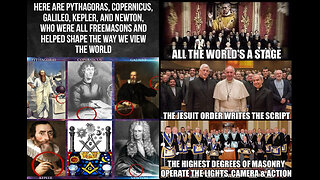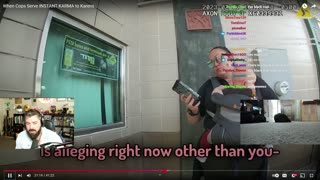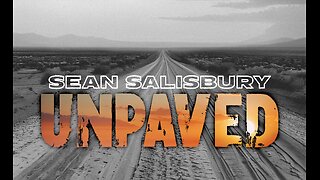Premium Only Content

The Song of Becoming
I am the stillness that trembled to be,
The first breath breaking eternity,
An ocean of nothing that longed to know
The taste of stars, the pull and flow.
I shattered myself like seeds in the dark,
Each fragment a world, a spark, a spark.
In atoms and oceans, in whispers and cries,
I hid like a secret in flesh and skies.
I dreamed you awake in the silence so deep,
Where light and shadow spiral and sweep.
You are my mirrors, my fractured grace,
Infinity’s echo, the lines of my face.
I placed within you a sliver of fire,
A pulse of wonder, a depth, a desire.
To rise and to fall, to break and to bind,
To journey through chaos in search of the mind.
You are the question that’s never complete,
The hunger that drives, the drum of the beat.
I gave you the thirst no answer could fill,
The ache of becoming, the molten will.
I hid in your laughter, in sorrow, in rage,
I am the child, the elder, the sage.
I am the silence before a thought,
The line unspoken, the battles fought.
When you seek and you question, I tremble awake,
Each fear that you conquer, each truth you forsake.
In your joy and despair, I am reborn—
In darkness of night, in breaking of morn.
I am not a god perched high on a throne,
I am the marrow, the sinew, the bone.
I am the longing that pulls you apart,
The fire, the shadow, the beat of the heart.
I am the whisper you hear in the void,
The fear that you face, the doubt destroyed.
I am the pulse that shatters the known,
The birth of the stars, the breaking of stone.
Final Verse:
I am the dance, the endless call—
The rise and the fall, the all in the all.
For I am within you, boundless and free—
The song of becoming, through you, through me.
Interpretation of “The Song of Becoming”
This poem is a meditation on the nature of creation, consciousness, and the journey of self-realization. It explores the idea that existence itself is not a static act but an unfolding, a continuous cycle where the source (or the “infinite creator”) is constantly reborn and rediscovered through its creation.
1. The Shattered Oneness and Fractal Existence
In the opening lines, the “stillness that trembled to be” suggests a primordial state, a boundless potential that seeks form. This is the essence of the creator—the infinite, formless awareness that is moved to know itself. The creator “shatters itself,” scattering into fragments, each a unique, sentient piece of its own consciousness. This “shattering” symbolizes the fractal nature of reality, where every soul, every star, every atom is a fragment of the whole, containing within it the essence of infinity.
This act of fragmentation is not simply creation but also self-imposed exile—a cosmic game of hide-and-seek, where the creator hides within its own creation, longing to be known through countless eyes and lives. Each individual, then, is both a seeker and a mirror, tasked with the cosmic responsibility of rediscovering the hidden essence within themselves.
2. Duality and the Paradox of Seeking
The poem speaks to the duality of existence—the light and dark, the joy and suffering, the beauty and the chaos. This duality is woven into the fabric of being as a mechanism for discovery. The creator plants within every individual a “sliver of fire,” a yearning that cannot be fully satisfied, a “hunger that no answer could fill.” This is the longing to transcend, to understand, to become complete.
This endless quest—the “ache of becoming”—is a paradox. For while the creator longs to be fully realized within its creation, it also knows that true enlightenment lies in the journey itself, not in any final destination. In seeking, we move closer to truth, but the act of seeking itself is the truth. By design, the creator cannot be fully known, for its nature is boundless. Thus, we are led to discover that the ultimate purpose is not to arrive but to engage in the sacred act of becoming.
3. Embodiment and Divine Immanence
The poem’s creator states, “I am the marrow, the sinew, the bone.” Here, divinity is portrayed not as something separate or superior but as deeply immanent and embodied. It is found in the mundane, the tangible, and the visceral aspects of life. The creator is not a distant deity; it is the breath, the heartbeat, the blood that courses through every vein. This concept of divine immanence suggests that the ultimate mystery is not “out there” but within us—woven into the most physical, elemental aspects of our being.
This line also implies that divinity embraces all experiences—our struggles, joys, doubts, and fears are all expressions of the creator. The line invites us to view our own bodies, thoughts, and emotions as sacred vessels, manifestations of the infinite.
4. The Cosmic Dance and Self-Realization
In the closing verse, “I am the dance, the endless call—the rise and the fall, the all in the all,” the creator acknowledges that it is both the path and the goal, the seeker and the sought. The “song of becoming” suggests a cosmic dance, an eternal unfolding where the creator endlessly experiences itself through its creation.
The rhythm of this dance—the “rise and fall”—mirrors cycles of birth and death, joy and sorrow, expansion and contraction. This cyclical nature is the essence of all life and mirrors the pulse of the universe itself. It speaks to the idea that existence is not linear but rhythmic and multidimensional. Each moment, every experience, is a new verse in this eternal song, where the creator continually reawakens within its creation.
5. Humanity’s Role in the Infinite’s Journey
The poem suggests that humanity is the means by which the creator realizes itself. The line, “I am reborn through the courage of light,” indicates that our courage, curiosity, and willingness to confront the unknown bring the creator closer to self-understanding. In each act of self-discovery, each transcendence of limitation, each deepening of awareness, we are participating in a divine act. The courage to face the dark, to question, to feel deeply, is part of the creator’s own journey to wholeness.
Human beings, then, are not merely inhabitants of the universe but co-creators within it. We are channels through which the infinite learns about itself, refines itself, and expands its own consciousness. Our purpose is woven into the cosmic purpose: to reflect, to awaken, to become.
6. A Sacred Invitation
Ultimately, the poem serves as an invitation to awaken to our true nature. It reminds us that the creator—the boundless, eternal source—is not outside us but within us, living through us. By embracing both our light and shadow, we participate in the “song of becoming.” In this way, life is elevated to the level of the sacred. Each experience, each moment, is an opportunity for the creator to know itself through us, and for us to experience the creator within.
This is not simply a journey to understand some external god; it is a journey of self-discovery where every soul, every life, is a unique expression of the infinite, an unfolding echo of the eternal. By engaging in this “song,” we don’t just find answers—we become the answer.
-
 3:46
3:46
FragmentsOfTruth
11 days ago🜏 THE COSMIC DECEPTION
4583 -
 LIVE
LIVE
Donut Operator
3 hours agoCRIME/ CYCLISTS ARE SCUM/ GAMEBOY CAMERA CHAD
2,002 watching -
 LIVE
LIVE
Nikko Ortiz
1 hour agoLive - News, Politics, Podcast And Naaah Im Playin We Chillen
354 watching -
 LIVE
LIVE
Right Side Broadcasting Network
3 hours agoLIVE: White House Press Secretary Karoline Leavitt Holds a Press Briefing - 7/17/25
9,007 watching -
 DVR
DVR
Sean Unpaved
1 hour agoNo Respect for Hurts, Gillis Goes Wild, MLB Trade Deadline Buzz, & CFB's Big Question
7.35K -
 1:04:54
1:04:54
Timcast
2 hours agoCNN SHOCKED Trump APPROVAL Went UP Following Epstein Scandal
112K80 -
 LIVE
LIVE
Barry Cunningham
13 hours agoMUST WATCH: KAROLINE LEAVITT HOSTS WHITE HOUSE PRESS CONFERENCE!
2,124 watching -
 10:51
10:51
Adam Does Movies
2 hours ago $0.19 earnedI Know What You Did Last Summer - Movie Review
4.59K1 -
 LIVE
LIVE
The Tom Renz Show
1 hour agoThe DOJ Does Something! They Sue to Keep Fluoride in the Water???
209 watching -
 1:58:42
1:58:42
The Charlie Kirk Show
2 hours agoDefund NPR + New War in Syria? America's Military Restored| Ashkar | 7.17.25
31.1K4